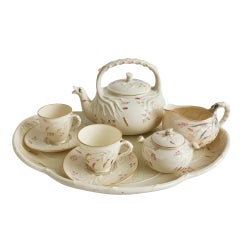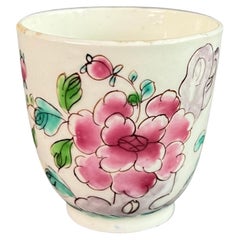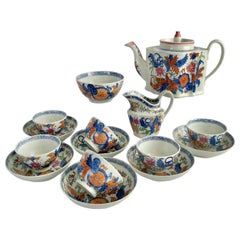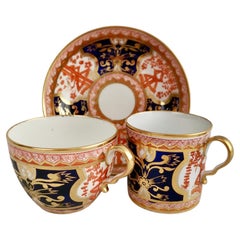Want more images or videos?
Request additional images or videos from the seller
1 of 15
Belleek Porcelain Cup and Saucer, Grass Pattern, Victorian 1863-1891
$275List Priceper set
About the Item
- Creator:Belleek Pottery Ltd. (Maker)
- Dimensions:Height: 1 in (2.54 cm)Width: 1 in (2.54 cm)Depth: 1 in (2.54 cm)
- Sold As:Set of 2
- Style:Arts and Crafts (In the Style Of)
- Materials and Techniques:
- Place of Origin:
- Period:
- Date of Manufacture:1863-1891
- Condition:Wear consistent with age and use. The set is in perfect antique condition without any damage, repairs, crazing or significant wear.
- Seller Location:London, GB
- Reference Number:Seller: A-BEL12a1stDibs: LU4805129487412
About the Seller
5.0
Vetted Professional Seller
Every seller passes strict standards for authenticity and reliability
Established in 2016
1stDibs seller since 2019
227 sales on 1stDibs
Typical response time: 2 hours
Authenticity Guarantee
In the unlikely event there’s an issue with an item’s authenticity, contact us within 1 year for a full refund. DetailsMoney-Back Guarantee
If your item is not as described, is damaged in transit, or does not arrive, contact us within 7 days for a full refund. Details24-Hour Cancellation
You have a 24-hour grace period in which to reconsider your purchase, with no questions asked.Vetted Professional Sellers
Our world-class sellers must adhere to strict standards for service and quality, maintaining the integrity of our listings.Price-Match Guarantee
If you find that a seller listed the same item for a lower price elsewhere, we’ll match it.Trusted Global Delivery
Our best-in-class carrier network provides specialized shipping options worldwide, including custom delivery.You May Also Like
Antique Fine Irish Belleek Porcelain Demitasse Cup and Saucer
By Belleek Pottery Ltd.
Located in Chula Vista, CA
Fine Irish Belleek Demitasse Cup and Saucer
basketweave shamrock eggshell antique porcelain
Saucer 4.5 Cup 2.5 x 2h
maker stamp present
hand painted
original estate preowned vintage ...
Category
Mid-20th Century Northern Irish Mid-Century Modern Porcelain
Materials
Porcelain
Antique Italian Doccia Topographical Porcelain Neoclassical Cup and Saucer
By Doccia Porcelain
Located in Philadelphia, PA
A very fine antique Italian Doccia Topographical porcelain neoclassical cup & saucer.
By Doccia Porcelain Manufactory circa 1820.
With pa...
Category
Antique Early 19th Century Italian Neoclassical Porcelain
Materials
Porcelain
$1,650 / set
H 2.5 in Dm 5.25 in
Antique Early 19th Century Spode Porcelain Pattern Number 2408 Tea Cup & Saucer
By Spode
Located in Philadelphia, PA
A fine antique Spode porcelain cup & saucer.
Pattern no. 2408
Decorated throughout with a cobalt floral patttern and extensive gilding.
Simply a great cup & saucer from Spod...
Category
Antique Early 19th Century English Neoclassical Porcelain
Materials
Porcelain
$295
H 2.63 in Dm 5.5 in
Antique Doccia Porcelain Italian Neoclassical Topographical Cup & Saucer
By Doccia Porcelain
Located in Philadelphia, PA
Offered here for your consideration is, A fine antique topographical porcelain cup & saucer.
By Doccia porcelain manufactory circa 1820.
...
Category
Antique 1820s Italian Neoclassical Porcelain
Materials
Porcelain
Richard Ginori Italian Porcelain Espresso Coffee Tea Cup Saucer
By Richard Ginori
Located in New York, NY
A beautiful vintage Italian porcelain espresso coffee or tea demitasse cup and saucer 'Toscana' by designer Richard Ginori, circa mid-20th century, ...
Category
Mid-20th Century Italian Country Porcelain
Materials
Ceramic, Porcelain
Spode Indian Tree Cup and Saucer
Located in Asheville, NC
This is an absolutely fabulous antique Copeland Spode Indian tree cup and saucer. It is a spectacular example of Spode porcelain with rust and orange...
Category
Antique 18th Century and Earlier English Porcelain
Materials
Porcelain
Early 19th Century Biedermeier Period Topographical Porcelain Cup and Saucer
By Meissen Porcelain
Located in Philadelphia, PA
A fine antique German Biedermeier period topographical porcelain cup and saucer.
The front decorated with a finely hand painted depiction of ...
Category
Antique 19th Century German Biedermeier Porcelain
Materials
Porcelain
$1,250
H 4.25 in Dm 5.13 in
Porcelain Coffee Cup and Saucer "Sirenas" Designed by Dalí, N°520/1000
By Salvador Dalí
Located in Paris, FR
Wonderful Porcelain Coffee cup and saucer "Sirenas peinadas con coral and hormiga" by Salvador Dalí. The famous surrealist artist created this model in 1977 with mermaids, red vivid corals and small ants on a white background. Each piece has a gold rim on the edges giving a very luxurious aspect.
Limited edition made of German porcelain produced by the Manufactory Schirnding...
Category
Late 20th Century German Porcelain
Materials
Porcelain
$449 / item
H 2.68 in Dm 5.12 in
Set of Six 18th Century Flight Worcester Porcelain Tea Cups and Saucers
By Flight, Barr & Barr Worcester
Located in Philadelphia, PA
A set of six antique Flight Worcester porcelain cups and saucers.
Each with a ribbed swirl design and cobalt blue and gold floral sprig and garland decoration.
Each base is mar...
Category
Antique Late 18th Century Great Britain (UK) George III Porcelain
Materials
Porcelain
$1,250 / set
H 2.75 in Dm 5.5 in
White and Gilt Neoclassical Cupid Arrow Cup & Saucer
Located in New York, NY
White and gilt neoclassical cupid arrow cup & saucer. Empire period designed white and gilt porcelain Valentine cupid's arrows and floral sprays. Under-glaze marks for Vienna. Aust...
Category
Antique Early 19th Century Austrian Empire Porcelain
Materials
Porcelain
More From This Seller
View AllBelleek Cabaret Tea Set for Two, Cream Grass Pattern, Victorian 1863-1891
By Belleek Pottery Ltd.
Located in London, GB
This is a beautiful and very rare Belleek cabaret set in the Grass design, consisting of a teapot, two teacups and saucers, a milk jug and a lidded sugar bowl, all placed on a large tray. All items carry the 1st Black Mark, which was used between 1863 and 1891.
It is extremely rare to come across an entire cabaret set of these antique items, particularly when in such fabulous condition, so this is a rare opportunity!
If you ever thought Belleek fine china looks, sounds and feels unique, you are right. There is a back story to this extraordinarily fine Irish eggshell porcelain, which has an unusually high amount of "frit" and therefore is thinner and finer than any other china.
Pottery in Belleek (in the now Northern-Irish area of Fermanagh) had started in 1849 with John Caldwell Bloomfield, who was a wealthy land owner. During the Irish famine...
Category
Antique Late 19th Century Northern Irish Victorian Tea Sets
Materials
Porcelain
Bow Porcelain Orphaned Coffee Cup, Famille Rose Peony, circa 1755
By Bow Porcelain
Located in London, GB
This is a very charming orphaned coffee cup made by the Bow Porcelain factory in about 1755. The cup is decorated in a Chinese "famille rose" peony pattern. This cup would have been part of a large tea service, and the tiny size shows how expensive coffee was in the 18th Century.
The Bow Porcelain Factory was one of the first potteries in Britain to make soft paste porcelain, and most probably the very first to use bone ash, which later got perfected by Josiah Spode to what is now the universally used "bone china". Bow was the main competitor of the Chelsea Porcelain Factory, but where Chelsea made very fine slipcast porcelain, Bow made a different soft paste porcelain that tended to be softer and could be pressed into moulds. Bow served a larger public generally at lower prices. The factory was only in operation between 1743 and 1774, after which the tradition got incorporated into some of the later famous potteries such as Worcester and Derby.
The cup is unmarked, which is normal for Bow items of this era.
Condition report the cup is in excellent condition without any damage or repairs. There are various glazing imperfections, which are quite normal for porcelain of this era.
Antique British porcelain...
Category
Antique 1750s English Rococo Tea Sets
Materials
Porcelain
New Hall Porcelain Tea Service, Japanese Tobacco Pattern, Georgian, circa 1795
By New Hall
Located in London, GB
This is a stunning tea service made by New Hall in circa 1795. The service is made of hybrid hard paste porcelain and decorated in a bold Chinoiserie pattern of large flower sprays. The service consists of a teapot with cover, a milk jug, a slop bowl, and six tea bowls with saucers.
This service has provenance; it came from the collection of David Redstone, the well known porcelain expert who wrote leading books on Bow and Chelsea porcelain.
The New Hall factory started as a cooperative of several Staffordshire potters making use of the porcelain license of Bristol Porcelain...
Category
Antique 1790s English George III Tea Sets
Materials
Porcelain
$2,900 / set
Free Shipping
Spode Porcelain Teacup Trio, Red Imari Dollar Pattern, Regency, ca 1810
By Spode
Located in London, GB
This is a beautiful orphaned teacup made by Spode in about 1810. It bears a lavish Japanese-inspired Imari pattern.
Spode was the great pioneer among the Georgian potters in England. Around the year 1800 he perfected the bone china recipe that has been used by British potters ever since, and he was also the leading potter behind the technique of transferware, making it possible for English potters to replace the Chinese export china, which had come to an end around that time, with their own designs. This was fundamental to a thriving industry that would last for about 150 years and provide half the world with their tableware. Spode porcelain is regarded as one of the highest quality porcelains around; for a soft-paste porcelain it is surprisingly hard and fine, and has a wonderful bright white colour.
The pattern on this can is called "Dollar" pattern, a very famous pattern that was used by English potters in the 18th and early 19th Century. It is obvious why it is called “dollar” - but its origin is less obvious! It is thought that this pattern was derived from a very old Chinese pattern depicting a tree with elaborate foliage that hides a Chinese character representing longevity or happiness. Traditionally, this went with a an image called “Taotie”, which was used on very ancient bronze vases...
Category
Antique Early 1800s English Regency Porcelain
Materials
Porcelain
Derby Coffee Cup, Monochrome Sepia Landscapes Zachariah Boreman, ca 1785
By Derby, Crown Derby
Located in London, GB
This is a very rare and stunning coffee cup and saucer made by Derby in about 1785. The set has a white ground with graceful gilding, and two stunning little landscapes painted by Za...
Category
Antique 1780s English Romantic Tea Sets
Materials
Porcelain
Samuel Alcock Porcelain Teapot, Blue, Gilt and Flowers, Rococo Revival ca 1837
By Samuel Alcock & Co.
Located in London, GB
A teapot with cover in the “rustic bean” shape, cobalt blue ground with gilt acanthus motif and finely painted flower posies on the belly of the teapot
Pattern 5782
Year: ca 1837
Si...
Category
Antique 1830s English Rococo Revival Tea Sets
Materials
Porcelain
Recently Viewed
View AllMore Ways To Browse
English Arts And Crafts Pottery
18th Century Antique Chinese Cup Saucer
Antique Hand Painted Tea Cups
Antique Eggshell Porcelain
Victorian Tea Cup
Cabaret Set
19th Century Belleek
Antique Belleek Pottery Ireland
Belleek Hand Painted
Irish Silver Tea Set
Irish Tea Set
Belleek China
Belleek Grass Pattern
Belleek Tea Cup And Saucer
Belleek Tea Set
Danish Teapot
England Tea Pots
Silver Tea Set London



